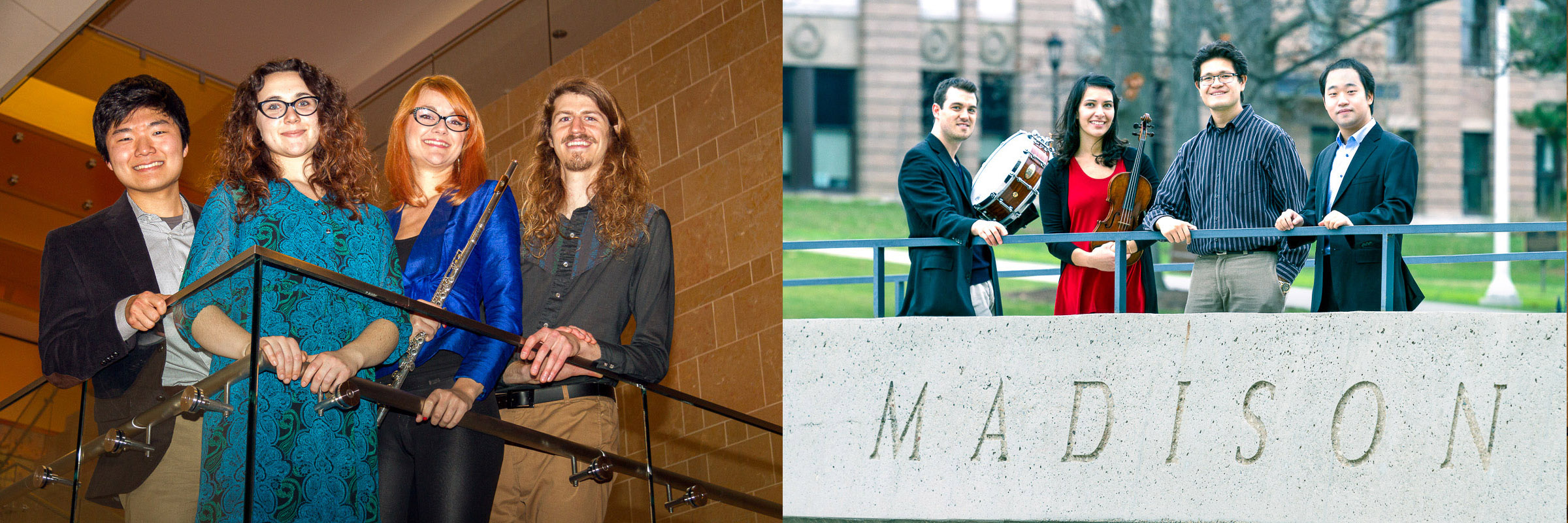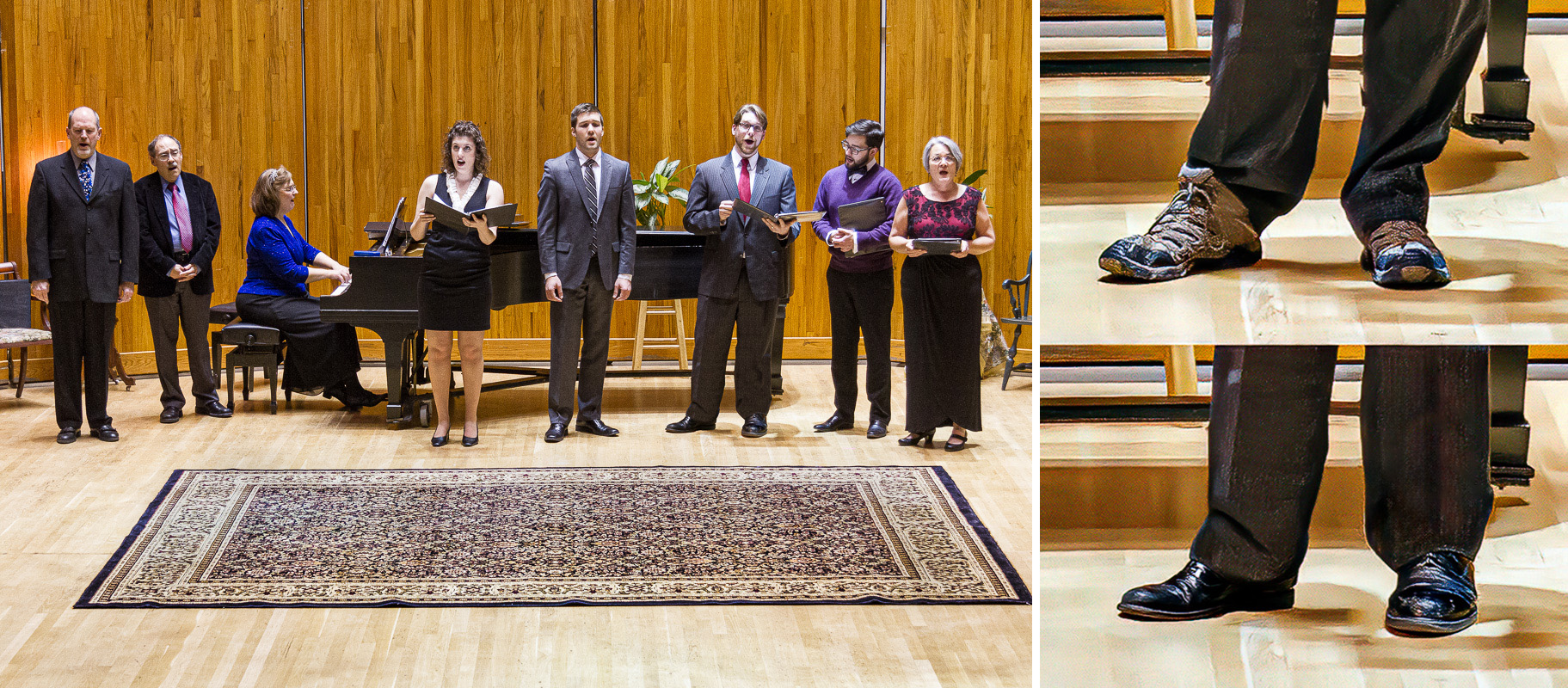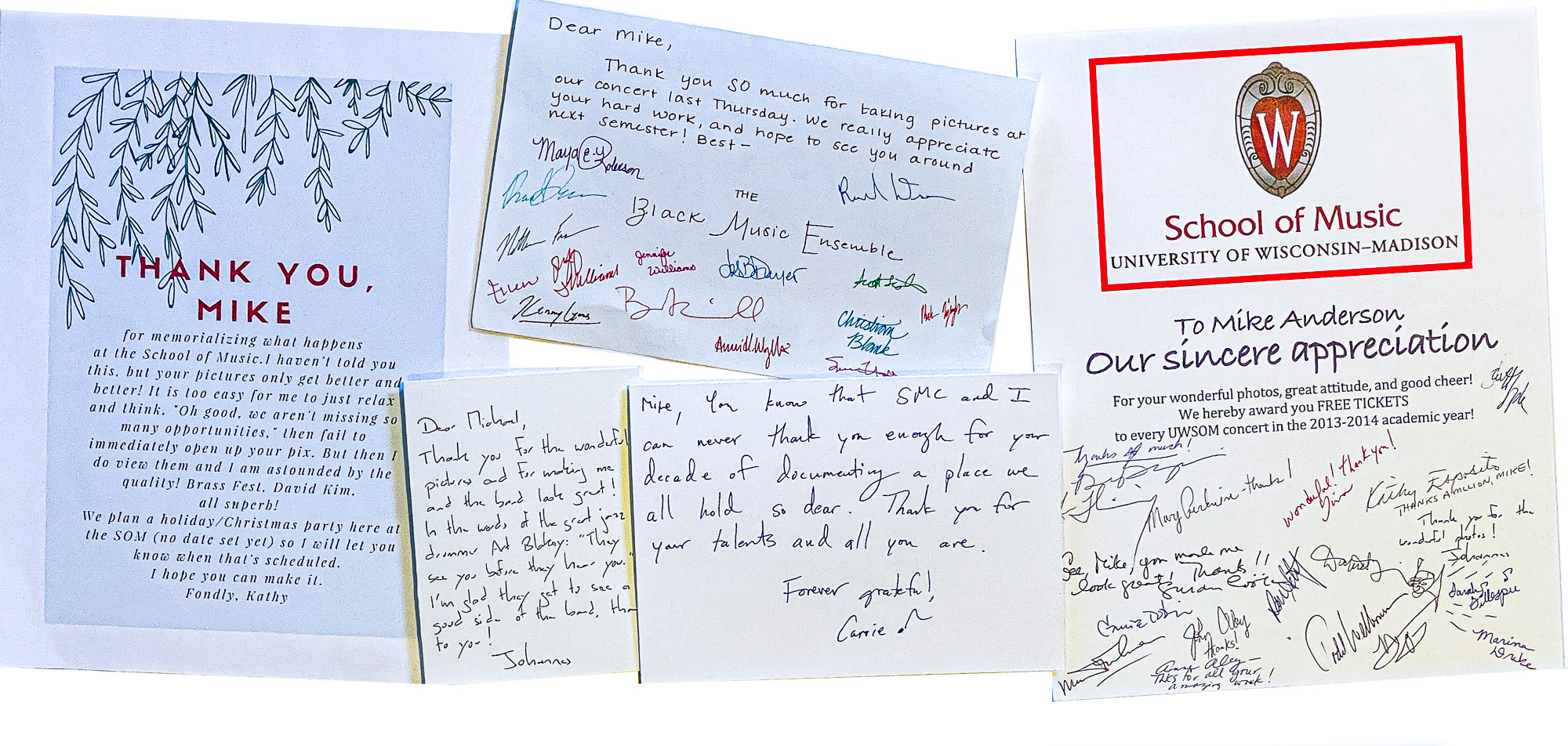
Sometimes unexpected situations arose that added some interest to my job. One of my annual tasks was to photograph the year’s Symphony Orchestra Concerto Contest Winners. These young musicians would be performing in that year’s Symphony Showcase. The first time I did this was a challenge. There were five musicians, but I could only meet two of them one week and the other three a week later. Also, if you’ve ever been in the concrete fortification from the 60s known as the Mosse Humanities Building, you know that the lighting inside ranges from bad to worse. To avoid having to stand outside in the November weather, I found a location by a nice bank of windows. That bank of windows was in a stairwell; a rather narrow stairwell.
I thought that the stairway railings might interfere with putting the two small group photos together so I also took a photo of each individual musician. After trying a few combinations I ended up with one using five separate photos that looked good enough. I wasn’t real happy with it, but it looked somewhat like all five were standing in front of a wide wall. The graphic designer improved it by leaving out the wall. I felt bad, however, when the tall, young violinist asked if I had intentionally made her shorter. I didn’t, but I hadn’t planned well enough to make sure each photo was the correct height. Sorry Madlen!
I did a much better job with the Concerto Winners from 2014 and 2015. I avoided the Humanities building! The 2014 photo was taken in the large windowed lobby of the Chazen Museim of Art and the 2015 image was taken outside with the group on the Park Street pedestrian overpass. For the overpass photo I stood in the middle of the street and asked the students to warn me if any cars were coming up on me from behind.

In case you’re curious, taking these photos involved a lot more than just saying “Smile!” and pressing the shutter. I had them try a variety of different poses in slightly different locations. In 2014 I took 33 photos; in 2015 I took 46 photos. Using photons is much cheaper than using film!
Once when I was getting ready to photograph the Schubertiade, one of the student performers arrived for the dress rehearsal a little upset. He was all dressed and ready to go, but he had forgotten to bring in his dress shoes. So, despite the nice shirt, tie and suit, he was still wearing some rather grubby looking old shoes. I told him that I would try to avoid showing his shoes in the photos. In a couple scenes he was on his knees and his shoes were out of sight behind him. When he was standing alone or next to one other person I was able to “cut him off at the knees.”
Near the end, however, there was a scene with all seven singers standing by the piano. The carpet was key to the scene since it represented Schubert’s vocal pieces as chamber music played in a palace or large room rather than a theater. So, I copied the shoes off of one of the other men and pasted them over his feet. I also had to straighten his pants a little where they bulged out because they were partially stuck in the top of his shoes. Although I doubted that this was a big deal, I knew that he was concerned and would certainly see it in the photos even if no one else did.

A similar problem came up with one of the operas. At the time of the final dress rehearsal for Falstaff, the set was not quite complete. The baseboards on the set were just bare wood. As with Schubert’s shoes, there were photos where I could easily omit that part of the scene. In this case, however, I didn’t know what the real baseboards would look like, so I decided to digitally “paint over” the bare wood and make it a smooth wall.
Once again, this was a minor change but at least it covered up the unfinished part of the set.
The most unusual request that I had was from Lawrence Earp, professor of musicology at the School of Music. He is considered the world’s foremost scholar on the manuscripts of medieval composer Guillaume de Machaut. Professor Earp wrote the introduction to the newly available digitized edition of a volume of illuminated manuscripts written in the 14th century by Machaut. He would be giving a talk on this work and would be showing some illustrations from it. To add some interest, maybe humor, he asked me to replace the head of one of the illustrated characters in the manuscript with his head. So, I took a few pictures of him and a few pictures of the manuscript page he wanted me to use and gave him what he wanted. Sad to say, I forgot to go back and ask him how his talk went.
Listening to music when I was young, I always “played along” by pounding on the arms of the couch or tapping on the table. This really drove my mother crazy, so much so that she eventually bought me some bongo drums that I could use, I mean was required to use, in my room. I might have become a drummer, had there been a need for one on the farm. I still tap on the steering wheel while sitting at a red light. So, even though there are percussionists in almost every musical group, I really enjoyed photographing some of the percussion classes and concerts offered by Tony di Sanza, professor of percussion, along with Todd Hammes and Tom Ross.
In some classes the students would be standing in the room holding the drums while rapping out their rhythm. In others, the drums were joined by xylophones, chimes, garbage can lids, and pans and kettles like my son used to pound on when he was old enough to crawl into the kitchen and open the cupboard. Sticks, mallets, hands and other implements of percussion would often be flying in all directions. It looked like some students were using violin bows to play the xylophones. I don’t think I’ve ever used the word cacophony in a sentence before and I won’t use it here because, although the sounds were often loud, they were not harsh or discordant. I quite enjoyed hearing them. However, I certainly didn’t understand the written version of some of this percussion music. In one class Todd Hammes filled the blackboard with more symbols than I’d ever seen in all my years of chemistry.
One of the percussion concerts I photographed had some very different and interesting numbers. In one, three students dressed in black sat behind a black barrier with an opening large enough to show only their hands above some boards. With the stage lights turned down, only the hands could be seen and heard as they tapped, clapped, snapped and slid across the boards. This was fascinating from both a visual and an aural perspective. At the end, the three performers leaned down to show their faces to the audience.

In another number, a very energetic performer danced and sang while being accompanied by two percussionists. I don’t remember what he sang, but I snapped quite a few photos to illustrate his moves.

My plan was to write two blog posts summarizing the events that I photographed for the UW-Madison Mead Witter School of Music. As you know, this is the fourth post already and there are still too many additional events to cover. So, although I will not cover them, I’d like to at least mention Dan Grabois and the $2 Broom, Mark Hetzler and Mr. Chair, the Black Music Ensemble, Soundwaves programs at the Wisconsin Institute for Discovery, Songs for Hope, Madrigal Singers, the Madison Early Music Festival, and even six School of Music Graduation Ceremonies. With apologies to those groups and others that I may have overlooked, I will finish with just the following two things.
Looking back at my photographs, I find that I really liked taking tight images, often of only one musician. Maybe I was focusing on their concentration or their energy. Maybe I sought a particular expression on their face. Maybe I hoped to capture that fraction-of-a-second pose that spoke of their performance. Even if I can’t clearly say what I mean, maybe the photos below will help you see what I mean.
I’m not saying that these pictures are the best of all that I’ve taken. I currently have 36,496 photos in my collection that are tagged “University of Wisconsin” and “School of Music.” Even if I had the time, I certainly wouldn’t have had the patience to go through all of them to find “the best.” These images are merely a few difficult-to-narrow-down examples of some that I like. Sad to say, but I do not know the names of these young musicians.
Finally, I’ve never had any training in the social graces, so I’m not quite sure if you should thank someone for sending you a Thank You card. But, I did receive a few over the years. I had a couple more than these but couldn’t find them. I even got a get well card when the fine doctors of the UW Hospital gave me a cricopharyngeal myotomy! (I had to look up how to spell that.)

Regardless of the graces, I really enjoyed my time meeting many professors and students, and being allowed to take candid photos that, I hope, did the job of illustrating the work being done by these fine musicians. Even though it’s doubtful that any of the people I mentioned will see their names, I will thank them just the same. Best of luck in your musical careers!